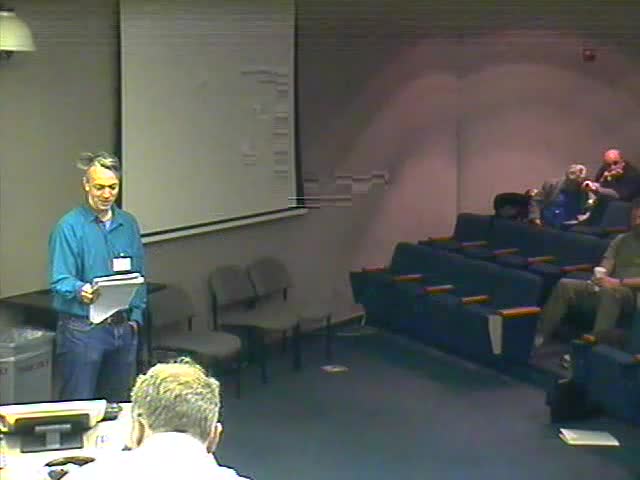Adaptation-driven Models of Cancer Invasion: Experimental Parameterization and Validation
Presenter
March 5, 2008
Keywords:
- Discrete-Continuous
MSC:
- 60J27
Abstract
Computer simulations based on the Hybrid Discrete-Continuous
(HDC) mathematical
model of cancer invasion (Anderson et al., Cell. 2006,127:905)
predict that the degree of severity
of the tumor microenvironment (tmE) directly impacts on the
emergence of invasion. More
precisely, harsh ME conditions (e.g., hypoxia, discontinuous
matrix, inflammation) select for
dominant aggressive clones that grow into a fingering,
infiltrating mass. In contrast, in mild ME
conditions (normoxia, homogenous matrix) selection for dominant
aggressive clones is relaxed,
so that they coexist with less aggressive ones and, together,
they grow into a smooth-margin, noninvasive
tumor mass. To populate HDC simulations with experimental data,
we use a panel of
cell lines, derived from the breast epithelial cell MCF10A. We
have established a collection of
variants of this platform cell line with distinct invasive
potential, generated by transfection of
oncogenes or passaging in vivo. We measured the following
parameters: oxygen
consumption/hypoxia, tumor cell proliferation, tumor cell
survival, metabolic consumption, and
matrix degrading enzyme activity. Initial simulations with
these homogenous data indicate that
invasion may require competition between phenotypes with
distinct adaptive traits to the tmE.
To validate these predictions in vitro, we have developed a
novel Island Invasion Assay (IIA),
which closely mimics the spatial arrangements of the HDC model.
Preliminary results suggest
that IIA supports the HDC predictions concerning invasion
(fingering) under stressful tmE
conditions. In addition, some unexpected results point to novel
features that could be included in
the HDC model to increase realism. This is an excellent example
of synergistic interactions
between modeling and experimentation, which will hopefully
produce novel insights in the
mechanisms underlying cancer invasion. For in vivo validation,
we are comparing orthotopic
(“mild ME”) versus subcutaneous (“harsh ME”) human breast
cancer xenografts in mice (in vivo
VICBC group, headed by Lisa McCawley). We utilized MCF-10
variant cell lines, CA1a and
CA1d, shown to have distinct and consistent tumorigenic
properties through repeated passage in
immunocompromised mice. Several in vivo imaging modalities are
being exploited to provide
quantitative analysis of cellular parameters of the same tumor
over time: Magnetic Resonance
Imaging (MRI) analysis to distinguish tumor volume and necrotic
tumor areas (i.e. nonoxygenated
states) from viable (i.e. oxygenated) tissue; positron emission
topography (PET) scan
imaging of 18F-labeled-fluorodeoxyglucose(FDG) for metabolism;
Optical imaging analysis of
fluorogenic probes termed “proteolytic beacons” for matrix
degrading protease activity (i.e.
substrate hydrolysis). Tumor specimens are also biopsied at
fixed volumes (0.5, 1 and 1.5 cm
diameters) for further ex vivo analyses, including histology to
assess invasion,
immunohistochemistry and immunofluorescence to measure cellular
proliferation (BrdU
incorporation), apoptosis (TUNEL) and hypoxia (hypoxiprobe).
Initial results from these analyses
reveal advantages and limits of in vivo parameterization and
validation. The main advantage is
that relevant variables and parameters for tumor invasion can
only be truly identified in a living
organism, at least until convincing in vitro surrogates for
spatial invasion, such as the IIA, are
developed. The limits reflect largely the fact that
conventional experimental biology has been
seldom used for model validation, so that tools and approaches
must be refined and adapted.
These broad issues as well as intitial specific data will be
discussed.
